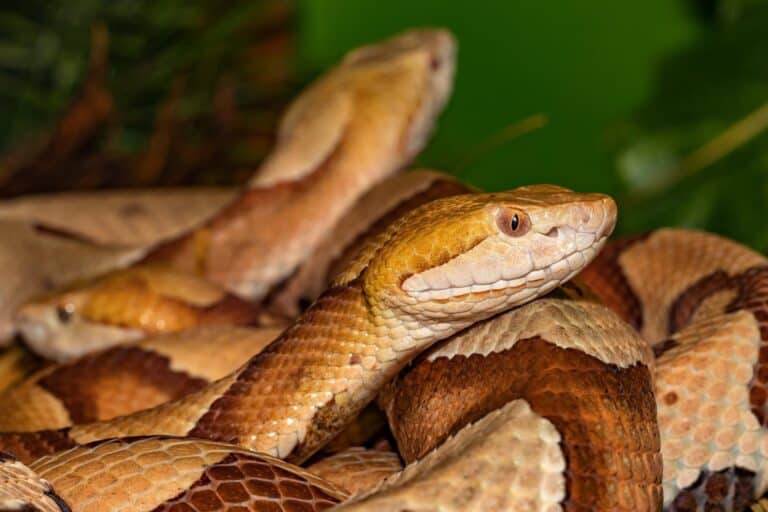Snakes are a common occurrence throughout the world and there are many different species. Usually, when the average person thinks of snakes they think of constrictors like anacondas and pythons or venomous snakes like rattlesnakes and cobras. Which brings us to the topic of this article: copperheads.
Are copperheads dangerous?
Yes, copperheads are dangerous because their bit is painful, and also venomous. Still, it’s very unlikely that you”’ die from a copperhead bite.
They are, however, very shy in nature, and prefer to hide rather than bite. Bites typically only occur when the snake is provoked, but seldom deliver a fatal dose of venom. Copperheads are members of the pit viper family.

Copperhead, a Pit Viper with an Extensive Range
Copperheads are members of the pit viper family of snakes, and are named for their distinctive tan coloring with brownish bands. A typical length is between 29 – 30 inches (males) and 24 – 26 inches (females). They are typically found in woodland areas in:
| Iowa | Arkansas |
| Connecticut | Alabama |
| Florida | Georgia |
| Ohio | Oklahoma |
| Delaware | Massachusetts |
| Kentucky | Missouri |
| Texas | Pennsylvania |
| North and South Carolina | Virginia and West Virginia |
| New York | New Jersey |
| Tennessee | Mississippi |
| Nebraska | Kansas |
| Maryland | Illinois |
Copperheads are also found in the Chihuahua and Coahuilla regions in Mexico. The copperhead’s extensive range means that encounters are common.
When do Bites Occur?
Behaviorally, these snakes are nocturnal in the summer but are active in the daytime during the spring and fall, hunting lizards, mice, voles, and various other prey items.
Generally, these snakes are NOT aggressive, but they tend to freeze and stay still when approached. Their camouflage makes them difficult to spot when they’re lying in the leaves and they tend to vibrate their tail (like a rattlesnake) as a form of warning when someone gets too close for comfort.
Still, they typically will only strike if physical contact is made (i.e. you step on them) and, frankly, I don’t blame them. If someone stepped on me, I’d be pretty miffed with them too – especially if I warned them to leave me alone in the first place!
The tail vibration is the first of two warnings. The second warning is a bite – which you’d get from handling or stepping on them.
Typically, the first bite is what’s known as a dry bite. This is when the snake bites without injecting the target area (i.e. your foot) with venom. The dry bite is the copperhead’s way of saying: “I’m here, leave me alone, or else!”
If a second bite is delivered, you get a dose of the copperhead’s venom. This is the: “I warned you” reaction to, possibly being stepped on again after the dry bite fails to ward off the threat.
The Venom of the Copperhead is Seldom Lethal
The venom of the copperhead is, surprisingly, seldom lethal to humans. Copperhead venom is the weakest – in terms of lethality – among the pit viper family. That said, the bite is still a decidedly unpleasant experience for the unfortunate soul who must endure it. Symptoms include:
- Excruciating pain
- A throbbing or tingling sensation
- Swelling
- Nausea
There’s also a risk of an allergic reaction and/or an infection which could make things worse.
Despite the unpleasantness of the experience, the estimated lethal dose of copperhead venom is around 100 milligrams. This is a good thing for those who are bitten, because copperheads typically only inject a relatively small amount of venom into a bite.
Now, with all of that said, don’t take a bite lightly. Please, if you are bitten by a copperhead (or any venomous snake for that matter), seek medical aid IMMEDIATELY!
Not Aggressive Despite their Reputation: Leave them Alone!
Copperheads are greatly feared but despite their perceived reputation; they aren’t usually aggressive.
I can’t stress this enough; these snakes are not aggressive by nature. They usually only bite if provoked and the person who gets bitten usually has a chance to avoid the venom by leaving after the dry bite is delivered.
Even if venom is injected, it’s rarely lethal. A bite may not be fatal, but it can still be a nasty experience and it’s not something you want to go through. So, what do you do if you find a copperhead?
You don’t bother them, and they won’t bother you. This is a rule that I learned early on while traversing the many hiking trails that my folks enjoyed, and it holds true here. If you find one, unless it’s necessary to interact with/handle the snake, just leave it alone to go about its business.
Don’t try removing it yourself, that’s a good way to get bitten. Call in animal control and have professionals remove it for you.
In Closing
In closing, as always; I hope you all enjoyed the article and found it informative. Thanks for reading, stay safe out there and I’ll see you for the next one!

Greg spent much of his younger years camping and hiking. Greg grew up on a small farm with lots of livestock such as cows, horses and chickens. He’s good with a bow and arrow, is a huge knife enthusiast, and has a blackbelt in Taekwondo.

Hmm, let it be known that I am not a snake fan of any kind or shape, But that being said. When we moved to the farm in the early to mid 50;s, my Dad took me aside and showed me two snakes that were beneficial, the garder ( don’t know about the spelling ) snake and the bull snake. They eat rodents, bugs and the like, although the bull snake looked mean as all get out. I remember one time when we had been on the farm for a period of time ( 1954 or so ), Mom had went into the cellar ( which was built into the ground under a hill ( the house we lived in was built in the 1890’s into the side of a hill ) and she came out screaming about a snake in the cellar. Dad came on the run to see what was going on, when he seen what was up, he got shovel or something and carried the snake out to the garden and the explained to Mom and me the difference. They weren’t poisonous, but boy did they look mean ( just a 70 something young man remembering what he thought as 7 yr old ). Gosh that’s been a long time ago.